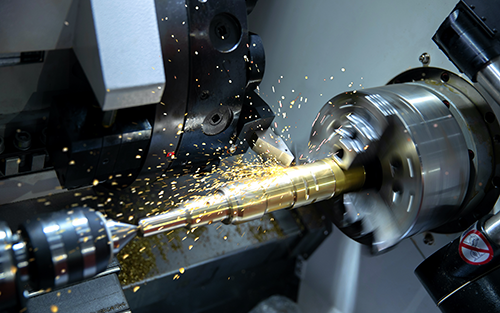- By Jack Smith
- August 09, 2023
- Siemens
- Feature
Summary
Smart virtual machines offer lower programming cost, advanced machine engineering, higher finished part quality and higher machine utilization.

Computer numerical control (CNC) machines play a vital role in a range of manufacturing applications. CNC machines transform materials, such as metal, composites, and plastic, shaping them into finished parts. As CNC machines continue to evolve, they require more complicated components, faster operating speed and more sophisticated software solutions.
Adaptive control and monitoring
The path toward digitalization is not necessarily about following a sequence of events or steps. Just getting started is the most important step.
The SINUMERIK Adaptive Control and Monitoring suite (ACM) from Siemens can guide both machine builders and end users along the digital transformation journey. The solutions encompass both hardware and software installed directly in machines to improve performance, PC-based smart virtual machines and even server-based solutions for managing the shop floor. The focus of ACM (which can be installed directly on the CNC) is on digitalization with the goal of accelerating manufacturing to increase productivity.
The ACM control sequence is shown in Figure 1. “When ACM is running in adaptive mode, it measures tooling load and spindle load, and based on that live load the software adjusts the feed rate override in real time,” said Gus Gremillion, solutions consultant at Siemens. “If the tool is underloaded, ACM detects the lower load on the tool and increases the feed override. The result is reduced cycle time. In addition, ACM can protect the tool by preventing tool overload.”

Gremillion said if a hard spot is encountered in the workpiece or if the tool is dulling and near end-of-life, ACM dials back the feed override to protect the tool, reduce tool breakage risk and extend tool life (Figure 2). “When the tool starts to see more overload past certain thresholds, the software triggers a tool change alert. Tool changes can also be automated to minimize the risk of tool breakage during operation.”
Gremillion said ACM is easy to use. He explains the process, which assumes a part program is in place. When the machine is run in learning mode, no changes are made to machine behavior. Tool-loading data is collected, and the software identifies the highest load type on the tool. After the part is run once, the machine can be changed from learning mode to adaptive mode.

Once in adaptive mode, the next time that specific part is run, ACM looks at the load. If it’s less than the load encountered during part-learning mode, the software increases the feed override. Conversely, if the tool is worn and starting to overload, the software starts dialing back that feed. If the feed must be dropped lower than a predetermined point, a feed hold is triggered for changing the tool.
The software does this automatically. No changes to the part program/G code are required. The software identifies which tool is loaded in the spindle, what operation is being performed, and augments its database automatically.
The role of digital twins
Digital twins are digital versions of physical objects or locations. People in numerous industrial sectors are using digital twins to gather more insight into the performance of their CNC machines and processes. A CNC trend to watch involves using digital twins during the setup process to avoid production surprises.
“We deal with the digital twin of the machine tools so [users] can validate their part programs, train their operators in an offline environment and estimate cycle time without having to be on the real machine,” said Gremillion.
Each machine has its own digital twin. “We target ways to improve smart CNC machine performance on the fly,” said Gremillion. “The digital twin environment is where users can check their part programs to determine cycle time, tool path optimization, crash avoidance and operator training/knowledge of how to run the part and use the machine tool.”
Industry 4.0 and digitalization
Industry 4.0 and digitalization have been big topics in recent years. “I think it’s seeing a resurgence, especially with some of the new capabilities that have come out in the last few years,” said Gremillion. “It’s important for users to have a clearly defined use case. A lot of times, when people start their digitalization journey, the thought process is, ‘Let’s get the data and then we can start working with it.’ If you have dedicated data scientists who have the time and resources to sift through that data to find those trends, that could certainly work.”
However, most manufacturing companies don’t have those type of resources. “It’s always good to establish clear cut goals, such as reducing cycle times by 5%, then select which solutions can help address those goals, deploy them, evaluate them and move forward from there,” said Gremillion. “Identifying use cases is important with any digitalization solution.”
This is the first article in the Machine Tool Digitalization series sponsored by Siemens. The other articles in the series include:
- Edge Computing Enables Smart CNC Machine Digitalization
- Digital Twins Validate Real-World CNC Machines
About The Author
 Jack Smith is senior contributing editor for Automation.com and ISA’s InTech magazine. He spent more than 20 years working in industry—from electrical power generation to instrumentation and control, to automation and from electronic communications to computers—and has been a trade journalist for more than 25 years.
Jack Smith is senior contributing editor for Automation.com and ISA’s InTech magazine. He spent more than 20 years working in industry—from electrical power generation to instrumentation and control, to automation and from electronic communications to computers—and has been a trade journalist for more than 25 years.
Did you enjoy this great article?
Check out our free e-newsletters to read more great articles..
Subscribe

